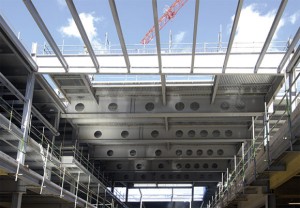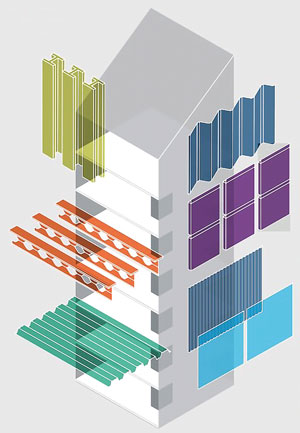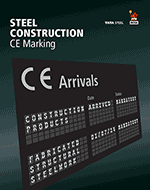Projects and Features
Advancing ahead
It’s four months since Corus launched the Advance branding for its beams, columns, channels, angles, and bearing piles manufactured in the UK, and many structural engineers and designers are beginning to take advantage of its benefits.
One of the main motivations behind the introduction of the Advance brand marking was the requirement for structural sections used in Europe to comply with the Construction Products Directive (CPD).
To specify the product standard (EN 10025:2004) is no longer sufficient and CE Marking is the simplest method to show compliance with the CPD.
As sections specified by designers need to comply with the CPD, Corus has simplified the process and was the first steel producer in the world to be approved to CE mark its sections and plates as meeting the requirements of the EU directive. Walter Swann, Corus Regional Technical Manager comments: “Engineers are today faced with a great deal of change in European legislation, and many of them are concerned about possible impacts on safety and efficiency of design. The CPD, as it affects structural steel, is one of these changes, and designers take great comfort that simply specifying Advance sections from Corus can effectively make the problem disappear,” he adds.
Over the past 10 years there has been a significant change in emphasis in steel design for buildings in the commercial sector. “Gone are the days when designers could specify the lightest section and be done with it. Designers, before they put pen to paper, have to consider how they can deliver the lowest cost building to their Client, and lightest no longer means cheapest,” says Mr Swann.
External cladding costs account for around 25% of the total cost of a building, compared to around 10% for the steel frame on a typical multi-story office block. The design team has to balance the costs between one element and another. Lighter beams are usually deeper which results in a taller building and higher cladding costs – invariably shallower heavier beams are the best option. “You throw pennies at the steel frame to save pounds on the cladding,” comments Mr Swann.
This is where the extended range offered by Advance really has something of interest to designers. The new range has extended key serial sizes at the heavier end, and introduced three new serial ranges, one of which is a “shallow and meaty,” 533 x 312 UKB series. “I’m sure this will be a huge success in the commercial and car park sectors where depth is critical, and it will allow designers to save those valuable pounds for their clients,” he adds.
Mr Swann goes on to say that it doesn’t stop there. “One of the new serial ranges, the 533 x 165 UKB, is perfect for the shed market, and there’s already been a lot of interest shown by fabricators who are active in this sector.
The new Advance range is not just simply a re-branding exercise of a standard product. It’s been carefully and thoughtfully extended to meet the demands of specific key sectors, whilst also ensuring that traditional markets are supplied with quality product,” says Mr Swann.
Another important advantage of steel and Advance are the recyclability credentials. “Sustainability is increasingly important for construction and it is now at the forefront of designers’ minds,” says Mr Swann.
Because sustainability is a relatively new issue, many engineers feel uncertain about how best to meet the requirements. “Sourcing materials, such as Advance sections, is a big step in the right direction,” Mr Swann sums up.











